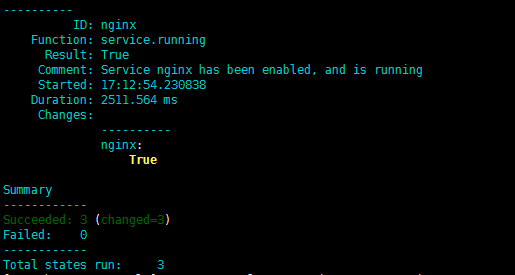saltstack SLS
SLS文件定义
SLS(代表SaLt State文件)是Salt State系统的核心。SLS描述了系统的目标状态,由格式简单的数据构成。这经常被称作配置管理
top.sls 是配置管理的入口文件,一切都是从这里开始,在master 主机上,默认存放在/srv/salt/目录.
top.sls 默认从 base 标签开始解析执行,下一级是操作的目标(被控主机),可以通过正则,grain模块,或分组名,来进行匹配,再下一级是要执行的state文件,不包换扩展名。
创建top.sls
(一)被控主机的匹配
#通过正则进行匹配的示例,
base:
'*':
- users #为users.sls或users目录 #通过分组名进行匹配的示例,必须要有 - match: nodegroup
base:
master1:
- match: nodegroup
- users #通过grain模块匹配的示例,必须要有- match: grain
base:
'os:CentOS':
- match: grain
- users
(二)编写state文件
首先说一下sls的命名空间
A)、SLS文件的扩展名 .sls 被省略。 (例如. webserver.sls 变成 webserver)
B)、子目录可以更好的组织,每个子目录都由一个点来表示.(例如 webserver/dev.sls 可以简称为 webserver.dev)
C)、如果子目录创建一个init.sls的文件,引用的时候仅指定该目录即可. (例如 webserver/init.sls 可以简称为 webserver)
D)、如果一个目录下同时存在webserver.sls 和 webserver/init.sls,那么 webserver/init.sls 将被忽略,SLS文件引用的webserver将只引用webserver.sls
示例:
1)初始化配置
[root@k8s_master salt]# cat /etc/salt/master | grep -v '^#\|^$'
cachedir: /var/cache/salt/master
auto_accept: True
file_recv: True
file_roots:
base:
- /srv/salt/
pillar_roots:
base:
- /srv/pillar
pillar_opts: True
nodegroups:
master1: 'L@k8s_master'
agents: 'L@k8s_node1,k8s_node2'
2)配置grains_module
创建目录并编写脚本
[root@k8s_master salt]#install -d /srv/salt/_grains [root@k8s_master salt]# cat /srv/salt/_grains/test_grains.py
#!/usr/bin/env python
#-*-coding:utf-8-*- import os,sys,commands def get_custom_grains():
grains = {}
_open_file=65535
try:
getulimit = commands.getstatusoutput('source /etc/profile;ulimit -n')
except Exception,e:
print e
print getulimit,type(getulimit)
if getulimit[0] == 0:
_open_file=int(getulimit[1])
grains['max_open_files'] = _open_file
return grains
刷新并重载模块
#同步grains模块,运行
[root@k8s_master pillar]#salt '*' saltutil.sync_all #刷新模块(让minion编译模块)
[root@k8s_master pillar]#salt '*' sys.reload_modules
验证
[root@k8s_master pillar]# salt '*' grains.item max_open_files
k8s_node1:
----------
max_open_files:
1024
k8s_node2:
----------
max_open_files:
1024
k8s_master:
----------
max_open_files:
1024
3)配置pillar
[root@k8s_master pillar]# cat top.sls
base:
'master1':
- match: nodegroup
- master1 'agents':
- match: nodegroup
- agents [root@k8s_master pillar]# cat master1.sls
nginx:
root: /www
[root@k8s_master pillar]# cat agents.sls
nginx:
root: /data
验证
[root@k8s_master pillar]# salt '*' pillar.data nginx
k8s_master:
----------
nginx:
----------
root:
/www
k8s_node2:
----------
nginx:
----------
root:
/data
k8s_node1:
----------
nginx:
----------
root:
/data
4)配置state
[root@k8s_master salt]# cat top.sls
base:
'*':
- nginx [root@k8s_master salt]# cat nginx.sls
nginx: #state名称
pkg: #管理对象类型:pkg(进行软件安装 yum/apt)
- installed #pkg要执行的方法: install,如果未安装就进行安装
file.managed:
- source: salt://nginx/nginx.conf #配置模板文件位置
- name: /etc/nginx/nginx.conf
- user: root
- group: root
- mode: 644
- template: jinja
- backup:minion #备份
- require:
- pkg: nginx
service.running:
- enable: True #检查服务是否在开机启动服务队列中
- reload: True #表示服务支持reload操作,不加则默认执行restart操作
- watch: #检测nginx.conf是否发生变化,如果发生变化会执行reload操作,pkg为确保nginx安装成功
- file: /etc/nginx/nginx.conf
- pkg: nginx
nginx.conf配置文件
[root@k8s_master salt]# cat nginx/nginx.conf
user nginx;
worker_processes {{ grains['num_cpus'] }}; #采用grains获取本地的值,与设备cpu核数一致
{% if grains['num_cpus'] == 2 %}
worker_cpu_affinity 01 10; #分配cpu
{% elif grains['num_cpus'] == 1 %}
worker_cpu_affinity 0001;
{% elif grains['num_cpus'] == 4 %}
worker_cpu_affinity 1000 0100 0010 0001;
{% elif grains['num_cpus'] >= 8 %}
worker_cpu_affinity 00000001 00000010 00000100 00001000 00010000 00100000 01000000 10000000;
{% else %}
worker_cpu_affinity 1000 0100 0010 0001;
{% endif %} worker_rlimit_nofile {{ grains['max_open_files'] }}; #文件描述符
error_log /var/log/nginx/error.log;
#error_log logs/error.log notice;
#error_log logs/error.log info; #pid logs/nginx.pid; events {
worker_connections {{ grains['max_open_files'] }} ; #与文件描述符数量一致
} http {
include mime.types;
default_type application/octet-stream; # log_format main '$remote_addr - $remote_user [$time_local] $http_host $request_method "$uri" "$query_string"'
# '$status $body_bytes_sent "$http_referer" $upstream_status $upstream_addr $request_time $upstream_response_time'
# '"$http_user_agent" "$http_x_forwarded_for"'; log_format log_json '{"@timestamp": "$time_iso8601","remote_addr": "$remote_addr","remote_user": "$remote_user","request_method": "$request_method","uri": "$uri","query_string": "$query_string","status": "$status","body_bytes_sent": "$body_bytes_sent","http_referrer": "$http_referer","upstream_status": "$upstream_status","upstream_addr" : "$upstream_addr","request_time": "$request_time","upstream_response_time": "$upstream_response_time","request": "$request","http_user_agent": "$http_user_agent","http_x_forwarded_for": "$http_x_forwarded_for"}'; # log_format json '{"@timestamp":"$time_iso8601",'
# '"host":"$server_addr",'
# '"clientip":"$remote_addr",'
# '"remote_user":"$remote_user",'
# '"request_method":"$request_method",'
# '"request":"$request",'
# '"uri":"$uri",'
# '"query_string":"$query_string",'
# '"http_user_agent":"$http_user_agent",'
# '"size":$body_bytes_sent,'
# '"responsetime":$request_time,'
# '"upstreamtime":"$upstream_response_time",'
# '"upstreamhost":"$upstream_addr",'
# '"url":"$uri",'
# '"domain":"$host",'
# '"client_realip":"$http_x_forwarded_for",'
# '"referer":"$http_referer",'
# '"status":"$status"}'; access_log /var/log/nginx/access.log log_json; sendfile on;
#tcp_nopush on; #keepalive_timeout 0;
keepalive_timeout 65; #gzip on; server {
listen 80;
server_name {{ grains['ip4_interfaces']['ens33'][0] }}; #获取本地的ip(grains)
root {{ pillar['nginx']['root'] }}; #获取web目录(pillar里定制)
index index.php index.html index.htm;
#charset koi8-r; #error_page 404 /404.html; # redirect server error pages to the static page /50x.html
#
error_page 500 502 503 504 /50x.html;
location = /50x.html {
root html;
}
location /ngx_status
{
stub_status on;
access_log off;
} location ~ ^/(status|ping)$
{
include fastcgi_params;
fastcgi_pass 127.0.0.1:9000;
fastcgi_param SCRIPT_FILENAME $fastcgi_script_name;
}
# proxy the PHP scripts to Apache listening on 127.0.0.1:80
#
#location ~ \.php$ {
# proxy_pass http://127.0.0.1;
#} # pass the PHP scripts to FastCGI server listening on 127.0.0.1:9000
#
#location ~ \.php$ {
# root html;
# fastcgi_pass 127.0.0.1:9000;
# fastcgi_index index.php;
# fastcgi_param SCRIPT_FILENAME /scripts$fastcgi_script_name;
# include fastcgi_params;
#}
location ~ \.php$ {
fastcgi_connect_timeout 300;
fastcgi_read_timeout 300;
fastcgi_send_timeout 300;
fastcgi_buffer_size 128k;
fastcgi_buffers 32 32k;
fastcgi_pass 127.0.0.1:9000;
fastcgi_index index.php;
fastcgi_param SCRIPT_FILENAME $document_root$fastcgi_script_name;
include fastcgi_params;
} # deny access to .htaccess files, if Apache's document root
# concurs with nginx's one
#
#location ~ /\.ht {
# deny all;
#}
} # another virtual host using mix of IP-, name-, and port-based configuration
#
#server {
# listen 8000;
# listen somename:8080;
# server_name somename alias another.alias; # location / {
# root html;
# index index.html index.htm;
# }
#} # HTTPS server
#
#server {
# listen 443 ssl;
# server_name localhost; # ssl_certificate cert.pem;
# ssl_certificate_key cert.key; # ssl_session_cache shared:SSL:1m;
# ssl_session_timeout 5m; # ssl_ciphers HIGH:!aNULL:!MD5;
# ssl_prefer_server_ciphers on; # location / {
# root html;
# index index.html index.htm;
# }
#} }
执行刷新state配置
[root@k8s_master salt]# pwd
/srv/salt
[root@k8s_master salt]#salt '*' state.highstate
效果图


saltstack SLS的更多相关文章
- saltstack SLS 安装haproxy+nginx实例分析学习
本文主要以实例的形式去熟悉sls的部署流程及相关模块的使用 文件下载:https://github.com/unixhot/saltbook-code 目录结构 [root@k8s_master sa ...
- Saltstack sls文件:批量安装服务
一.使用saltstack 批量安装nginx 1.创建salt目录 mkdir /srv/{salt,pillar} 2.再/srv/salt/下创建sls文件 vim nginx_install. ...
- Saltstack sls文件:批量添加删除计划任务
一.使用sls文件 批量添加计划任务 1.创建salt目录 mkdir /srv/{salt,pillar} 2.再salt目录下创建文件 vim crontab.sls 3.添加内容 # 添加的命令 ...
- Saltstack sls文件:批量替换指定文件
一.创建salt管理配置文件:将所有minion 指定文件替换为master端的文件. 1.创建salt管理目录,并创建salt配置文件规范 # 创建salt文件目录 mkdir /srv/{salt ...
- saltstack pillar
piller组件定义与客户端相关的任何数据(定义在master端),定义好的数据可以被其他组件调用(如state,api) 说通俗了,一句话,就是ansible vars里定义的变量,可以在整个pla ...
- 【04】Saltstack:配置管理
写在前面的话 当我们需要进行一系列可重复且复杂的操作的时候,如果还继续用传统的 cmd.run 来执行显然难以满足我们的需求.这时候就会在想一个问题,我们能不能把这些操作编辑成一个类似脚本的操作,我们 ...
- 死磕salt系列-salt入门
saltstack简介 SaltStack是一种新型的基础设施管理软件,简单易部署,可伸缩的足以管理成千上万的服务器,和足够快的速度控制,与他们交流,以毫秒为单位.SaltStack提供了一个动态基础 ...
- 自动化运维工具SaltStack - 多环境(使用记录【state.sls 与 state.highstate】)
转自:https://segmentfault.com/a/1190000000513137 今天在进行 saltstack 多环境的时候,遇到一个问题,最终得到解决,好记性不如烂笔头,记录. 首先, ...
- saltstack之sls文件配置
state模块 state模块会调用它的sls函数处理一个以.sls结尾的配置文件. sls文件是YAML语言来进行描述的 缩进 不要使用`tab`因为tab是四个空格,而YAML是使用两个空格 冒号 ...
随机推荐
- 【C/C++】递归算法
所谓递归——函数的递归调用.c语言的这种特性给程序设计带来许多方便.尤其是接触数据结构时,会发现递归的出现频率非常之高,也行之有效~下面是笔者在接触递归这个东西时的一些个人总结和体会: 1.直接或间接 ...
- Django的View(视图)
Django的View(视图) 一个视图函数(类),简称视图,是一个简单的Python 函数(类),它接受Web请求并且返回Web响应. 响应可以是一张网页的HTML内容,一个重定向,一个404错误, ...
- 洛谷3703 [SDOI2017] 树点染色 【LCT】【线段树】
题目分析: 操作一很明显等价于LCT上的access操作,操作二是常识,操作三转化到dfs序上求最大值也是常识.access的时候顺便在线段树中把对应部分-1,把右子树的子树+1即可. 代码: #in ...
- Codeforces Round #530 (Div. 2) A,B,C,D
A. Snowball 链接:http://codeforces.com/contest/1099/problem/A 思路:模拟 代码: #include<bits/stdc++.h> ...
- WINDOWS 包管理器 Chocolatey
https://chocolatey.org/ - 官网 安装: @"%SystemRoot%\System32\WindowsPowerShell\v1.0\powershell.exe& ...
- 自学Python3.4-函数分类(匿名函数)
自学Python之路-Python基础+模块+面向对象自学Python之路-Python网络编程自学Python之路-Python并发编程+数据库+前端自学Python之路-django 自学Pyth ...
- Codeforces | CF1028C 【Rectangles】
(这道题太简单啦...虽说我锤了一上午都没过...我能说这道题和\(CF1029C\)算是同一道题吗...) 按照时间顺序来说...\(CF1029\)在\(CF1028\)前面(而且\(CF1029 ...
- Mac上连接nifi
1. open terminal 2. ssh root@nifi.webus.cn 3. logs cd /var/lib/nifi/logs 4. view log tail -100 ...
- css颜色表示法
css颜色值主要有三种表示方法: 1.颜色名表示,比如:red 红色,gold 金色 2.rgb表示,比如:rgb(255,0,0)表示红色 3.16进制数值表示,比如:#ff0000 表示红色,这种 ...
- 按奇偶排序数组 II
题目描述 给定一个非负整数数组 A, A 中一半整数是奇数,一半整数是偶数. 对数组进行排序,以便当 A[i] 为奇数时,i 也是奇数:当 A[i] 为偶数时, i 也是偶数. 你可以返回任何满足上述 ...
